|
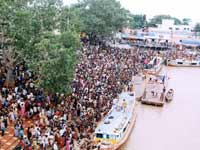 Once
every twelve years, in the southern part of the Indian peninsula,
millions of people congregate at the temple town of Rajamundry,
on the banks of the mighty river Godavari. They are consumed
by only one desire: to take a dip in the Holy river during
this auspicious period called Pushkaram. The Hindus believe
that a dip in the Godavari during this period rids one of
all impurities: physical and mental. This of course is in
consonance with the Hindu practice of revering all aspects
of nature as a direct manifestation of the Divine. Whatever
may be the other religious or spiritual reasons for this event,
the fact is, that over a period of 12 days, in the month of
August 2003, specific spots along the banks of Godavari witnessed
a convergence of lakhs of people everyday….yes, lakhs
of them everyday! Once
every twelve years, in the southern part of the Indian peninsula,
millions of people congregate at the temple town of Rajamundry,
on the banks of the mighty river Godavari. They are consumed
by only one desire: to take a dip in the Holy river during
this auspicious period called Pushkaram. The Hindus believe
that a dip in the Godavari during this period rids one of
all impurities: physical and mental. This of course is in
consonance with the Hindu practice of revering all aspects
of nature as a direct manifestation of the Divine. Whatever
may be the other religious or spiritual reasons for this event,
the fact is, that over a period of 12 days, in the month of
August 2003, specific spots along the banks of Godavari witnessed
a convergence of lakhs of people everyday….yes, lakhs
of them everyday!
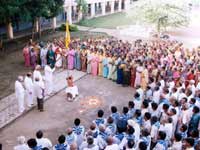 Imagine
the consequences of such an event. The very numbers implied
a system operating on the edge of chaos…with every possibility
of things going wrong: stampedes, public health disasters,
and deaths by drowning. Moreover, majority of the devotees
who came there belonged to the poorer sections of the society;
with just a pair of clothes, little for their food and a bounty
of faith! The government, of course, did its best to organize
this mega event. But it had its own limitations as far as
the resources and manpower was concerned. This was where many
voluntary groups swung into action and foremost on the list
was the Sri Sathya Sai Seva Organization of Andhra Pradesh. Imagine
the consequences of such an event. The very numbers implied
a system operating on the edge of chaos…with every possibility
of things going wrong: stampedes, public health disasters,
and deaths by drowning. Moreover, majority of the devotees
who came there belonged to the poorer sections of the society;
with just a pair of clothes, little for their food and a bounty
of faith! The government, of course, did its best to organize
this mega event. But it had its own limitations as far as
the resources and manpower was concerned. This was where many
voluntary groups swung into action and foremost on the list
was the Sri Sathya Sai Seva Organization of Andhra Pradesh.
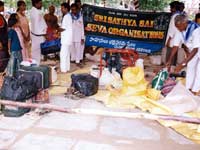 On
the 29th of July, 2978 volunteers of the organization gathered
at the Sathya Sai Gurukulam at Rajahmundry and made a commitment
to unto themselves: 'We shall see SAI in every pilgrim we
encounter and serve him/her to the best of our capacity'.
Several months of planning had gone into this event. All the
raw materials were ready. Three buses and four trucks were
in place, ready for use. Every volunteer was given specific
duties at specific locations. The service was to be rendered
in turns by batches of thousand volunteers (600 men, 400 women),
for a period of four days each. On
the 29th of July, 2978 volunteers of the organization gathered
at the Sathya Sai Gurukulam at Rajahmundry and made a commitment
to unto themselves: 'We shall see SAI in every pilgrim we
encounter and serve him/her to the best of our capacity'.
Several months of planning had gone into this event. All the
raw materials were ready. Three buses and four trucks were
in place, ready for use. Every volunteer was given specific
duties at specific locations. The service was to be rendered
in turns by batches of thousand volunteers (600 men, 400 women),
for a period of four days each.
Taking the name of SAI, the volunteers plunged into service.
One could see SAI volunteers wherever one went. As soon as
one walked into bus terminals and railway stations, volunteers
offering service in the free cloakroom facility welcomed them.
There were others who gave guidelines on how to reach the
bathing ghats. The volunteers were there near the bathing
ghats too, maintaining cleanliness and helping the old and
the disabled to take a dip. They took care of the children
when the parents went for their holy dip. They prevented stampedes
by helping police maintain the queue.
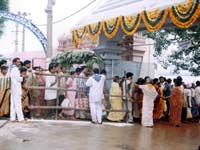 There
was no outbreak of any kind. Volunteers supplied pure drinking
water, carrying water tanks on their backs. Medical camps
were organized on the banks to tackle any health problems.
Others were seen cleaning the river water of the offerings
that the devotees made. Some others were busy elsewhere preparing
large quantities of food, which was given away in the form
of packets, free of cost, to the pilgrims everyday. The total
number of packets given in these twelve days was a staggering
3,27,750! There
was no outbreak of any kind. Volunteers supplied pure drinking
water, carrying water tanks on their backs. Medical camps
were organized on the banks to tackle any health problems.
Others were seen cleaning the river water of the offerings
that the devotees made. Some others were busy elsewhere preparing
large quantities of food, which was given away in the form
of packets, free of cost, to the pilgrims everyday. The total
number of packets given in these twelve days was a staggering
3,27,750!
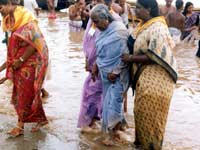 The
numbers would surely have impressed you too. But there was
also quality to this quantity. The pilgrims and the newspapers
were all praise for the wonderful service rendered by the
Sathya Sai Seva Dal. In response to all this one of the young
volunteers from Rajamundry remarked, " We only pray that
this little act of serving His devotees, has pleased Bhagwan!" The
numbers would surely have impressed you too. But there was
also quality to this quantity. The pilgrims and the newspapers
were all praise for the wonderful service rendered by the
Sathya Sai Seva Dal. In response to all this one of the young
volunteers from Rajamundry remarked, " We only pray that
this little act of serving His devotees, has pleased Bhagwan!"
Not many of us get a chance to serve the Lord directly…but
a service to those who seek Him, is by itself service unto
Him!
JAI SAI RAM
Dear Readers…
If you have stories from your land, where your people have
touched the lives of others in any little way through their
service and love…let us know about it.
We seek your inspiration on this path, too!
|